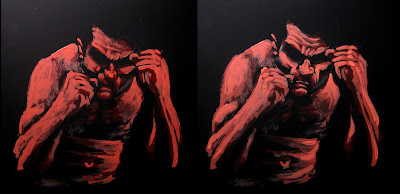What the heck- I took the photos, I kept notes and I used my Foundry paints to do the illustration of the bareknuckle fighter, so here's a short, basic step-by-step of how I went about it.
I'm not the best at illustrating the human form, so I searched the web for a few images of boxers in the pose of the final piece (I knew what I wanted to paint, how it was going to look, I just had to actually do it.) Once I got enough photos together, I used Photoshop to essentially make a digital collage of various parts of different photos and constructed the fighter I wanted to paint (and, like a dumbass, I didn't save a copy of this "collage.")
Then I made a printout of this piece at the size I was going to paint it.
Meanwhile, I primed a pre-gessoed masonite panel (8"x10"; cost just a couple bucks at Hobby Lobby) with some black craft paint. While the paint dried, I took the printout of my fighter and, on the backside of it, I rubbed the side of a white colored pencil all over the paper, thoroughly covering it (you could probably also use white pastel or chalk or white charcoal; colored pencil was all I had at hand.) Now lay the printout -- penciled side down -- against the masonite board (make sure the paint is dry!) Holding the printout flat and steady, use a pencil, pen or scribe and trace the lines of the printout. This will transcribe a basic line drawing to your masonite board. Now we can paint!
Under each of the following pictures, I simply state which colors I used. If you try something similar, it's up to you what colors you use and how you apply them. Since this piece was inspired in part by the works of George Bellows, I only used my crappy drybrushes to lay down the paint; I wanted an impressionistic look to the painting- something that had bold strokes when you look up close, but that all came together when you pulled back to look at it as a whole. This is a similar method I use for my painting my minis. OK, on to the few quick pics:




Nice use of Chiaroscuro.
ReplyDeleteTony
http://dampfpanzerwagon.blogspot.com/